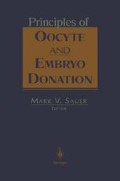Abstract
In 1983 the first woman with ovarian failure gave birth to a healthy child using a donated egg fertilized with her husband’s sperm.1 Since that time the use of donor eggs in alternative reproductive procedures, as well as the number of egg donation programs, has increased at a dramatic rate. Innovative medical techniques offer infertile couples an opportunity to create a pregnancy with at least some of their own genetic material, or in some cases to contribute to the gestational development of their own child. For some, this genetic component carries great weight in their decision to become a parent. Heredity has been shown to create a profound psychological bond between parents and their children.2
The authors would like to thank and acknowledge David Trejo, Esq., for his excellent research compiled for this chapter.
Access this chapter
Tax calculation will be finalised at checkout
Purchases are for personal use only
Preview
Unable to display preview. Download preview PDF.
References
Lutjen, P, et al. The establishment and maintenance of pregnancy using in vitro fertilization and embryo donation in a patient with primary ovarian failure. Nature. 1984; 174: 307.
Schiff, AR. Solomonic Decisions in Egg Donation: Unscrambling the Conundrum of Legal Maternity. 80 Iowa L. Rev. 265, 275.
See Anna JV, Mark C, 286 Cal. Rptr. 369, 380–81 (1991).
Schiff, AR at 269.
Johnson v. Calvert, 5 Cald. 4th 84 at 92.
Ferguson, SA. Surrogacy Contracts in the 1990’s: The Controversy and Debate Continues. 33 Duq. L. Rev. 903 (1995).
Id. at 910.
Gostin, L. A Civil Liberties Analysis of Surrogacy Arrangements in Surrogate Motherhood 3 (Larry Gostin ed., 1990) at 13 (citing Brady v US, 397 US, 742, 748 (1970)).
Johnson v Calvert, 5 Cal. 4th 84, 100 (1993).
Moschetta v Moschetta, 30 Cal Reptr 2d 893, 894 (Cal 4th App Dist 1994).
Ferguson, S at 921.
Jaycee B at 729.
Katz, KD. Ghost Mothers: Human Egg Donation and the Legacy of the Past 57 Alb. L. Rev. 733 (Summer, 1994).
Jaycee B., 42 Cal App 4th 718, n 3.
Schiff, AR at 272.
Id. at 285.
Burns, LM. Patient Information and Informed Consent: Current Practice, Legal and Ethical Concerns.
Andrews, LB. Symposium on Biomedical Technology and Health Care: Social and Conceptual Transformations: Technical Article: Alternative Reproduction. 65 S. Cal. L. Rev. 623, 655 (1991).
Office of Technology Assessment. 100th Cong., 2d Sess., Artificial Insemination Practice in the United States: Summary of a 1987 Survey, at 3 (Comm. Print 1988).
Andrews, LB at 655.
Katz, KD at 739.
Andrews, LB. New Conceptions: A Consumer’s Guide to the Newest Infertility Treatments Including In Vitro Fertilization, Artificial Insemination, and Surrogate Motherhood 158 (1985).
Andrews at 660.
Id.
Schiff at 283.
Katz at 772.
Katz at 774.
In Vitro Fertilization: Insurance and Consumer Protection. 109 Harv. L. Rev. 2092, 2103.
Id. at 2104.
Andrews, L. Who Is the Patient in Egg Donation? Chicago-Kent College of Law.
Katz at 736.
National Prenatal Statistics Unit. Fertility Society of Australia, IVF and Gift Pregnancies: Australia and New Zealand, 1987, at 11.
Andrews at n 90.
Andrews at 653.
Id.
Id. at 634.
In Vitro Fertilization: Insurance and Consumer Protection. 109 Harv. L. Rev. 2092, 2106.
Id. at 2108.
Jaycee B. at 718.
Davis v Davis, 842 S.W. 2d 588, 590 (Tenn. 1992).
Dow, S. Scientists crack secret of freezing eggs. The Australian. 1994, June 20; at 2.
Andrews at 662.
Unif. Parentage Act at 3, 9B U.L.A. 297–98 (1987).
Editor information
Editors and Affiliations
Rights and permissions
Copyright information
© 1998 Springer Science+Business Media New York
About this chapter
Cite this chapter
Handel, W., Vorzimer, A.W., Shafton, L.A. (1998). Consents and Contracts. In: Sauer, M.V. (eds) Principles of Oocyte and Embryo Donation. Springer, New York, NY. https://doi.org/10.1007/978-1-4612-1640-7_14
Download citation
DOI: https://doi.org/10.1007/978-1-4612-1640-7_14
Publisher Name: Springer, New York, NY
Print ISBN: 978-1-4612-7226-7
Online ISBN: 978-1-4612-1640-7
eBook Packages: Springer Book Archive

